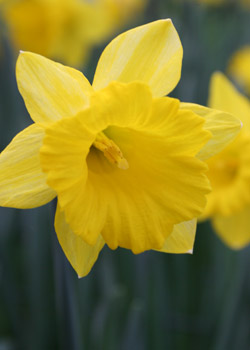Daffodil Bulbs Information

Great for adding bright, vibrant color to the garden while being an extremely low maintenance bulb, daffodils (or Narcissus as they are sometimes called) could hardly be more successful in the spring landscape! Their vigorous, long-lasting bulbs are extremely at home in well-drained, sunny locations and multiply quite quickly, making them great for naturalizing.
Available in a large variety of colors and types, this durable and versatile bulb works great when planted in mass or when used in pots. Their sturdy stems and long-lasting blooms also make them great when used for fresh floral arrangements. Daffodils can be used in just about any situation: to beautify a boulevard, along a driveway, underneath a grove of trees, or even naturalizing in the lawn. One of the best parts of this versatile bulb is that they are despised by pesky rodents and grazing deer!
Plant Information
- Planting Time: Fall
- Bloom Time: Early to Mid-Spring
- Hardiness Zone: 3-8
- Suitable Zone: 3-9
- Light Needs: Partial - Full Sun
Planting Daffodils
- Daffodils are typically planted in fall. Their roots will form in fall and they will bloom in mid to late spring, depending on the variety.
- Like most bulbs, daffodils do not enjoy sitting wet in the soil. Therefore, choose a location that is well-drained. Be sure the area where you will be planting receives a full or at least half day of sun.
- Large daffodil bulbs should be planted "pointed side up" approximately 4-6" apart, while the smaller, miniature daffodils need 2-3" of space. Dig a hole for the bulbs that is approximately 6-8" in depth for large bulbs and approx. 2" deep for miniature ones. Plant them one bulb per hole or dig a slightly wider hole and place a larger odd number (5-7) of bulbs in the same hole, creating more of a "bouquet affect" in your garden.
- Thoroughly soak the area with water once all the bulbs have been planted. Roots will form in fall and then the bulb will sprout and bloom in spring. Water as needed while the plant is growing and blooming.
- After the flowers have died, allow the foliage to yellow and die back. The leaves will continue to gather sunlight and make food for next year's blooms.
- Once the foliage has yellowed and dried, it may be removed by gently pulling it out of the soil. If the leaves do not easily pull away from the bulb, they are not ready to be removed. After you remove the foliage, your daffodils will be dormant and ready to "rest" until next year!